Analysis of Nursing Professional Accountability and Patient Safety
VerifiedAdded on 2022/09/25
|9
|2286
|18
Report
AI Summary
This report analyzes a case of professional misconduct involving a registered nurse, Ms. Tammy Jacobsen, who was suspended for six months due to actions contributing to adverse patient outcomes. The case details the inappropriate use of syringe drivers for medication administration, against established protocols, and the withholding of fluids and nutrition from a patient. The report examines Ms. Jacobsen's actions, omissions, and the contributing factors, including her disregard for medical orders and lack of adherence to evidence-based nursing practices. It identifies that the absence of standardized medication processes and a lack of leadership contributed to the adverse outcomes. The report outlines the actions Ms. Jacobsen should have taken to prevent these outcomes, emphasizing the importance of evidence-based decision-making, adherence to medication administration protocols, and maintaining professional standards. It also highlights the role of technology and safe systems in preventing medication errors and promoting patient safety. The conclusion stresses the importance of adhering to professional standards and implementing safe practices to prevent similar incidents in the future.
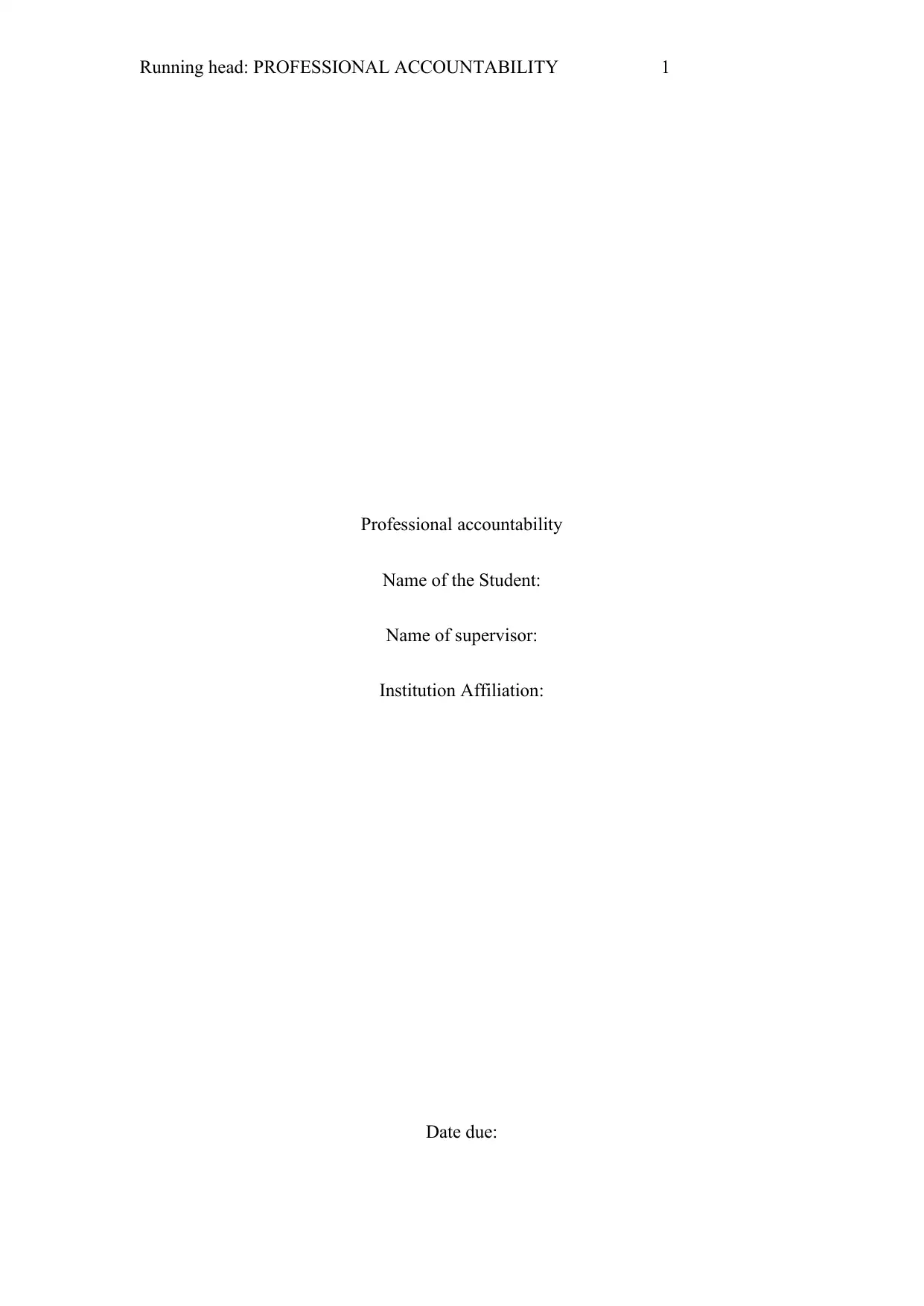
Running head: PROFESSIONAL ACCOUNTABILITY 1
Professional accountability
Name of the Student:
Name of supervisor:
Institution Affiliation:
Date due:
Professional accountability
Name of the Student:
Name of supervisor:
Institution Affiliation:
Date due:
Paraphrase This Document
Need a fresh take? Get an instant paraphrase of this document with our AI Paraphraser
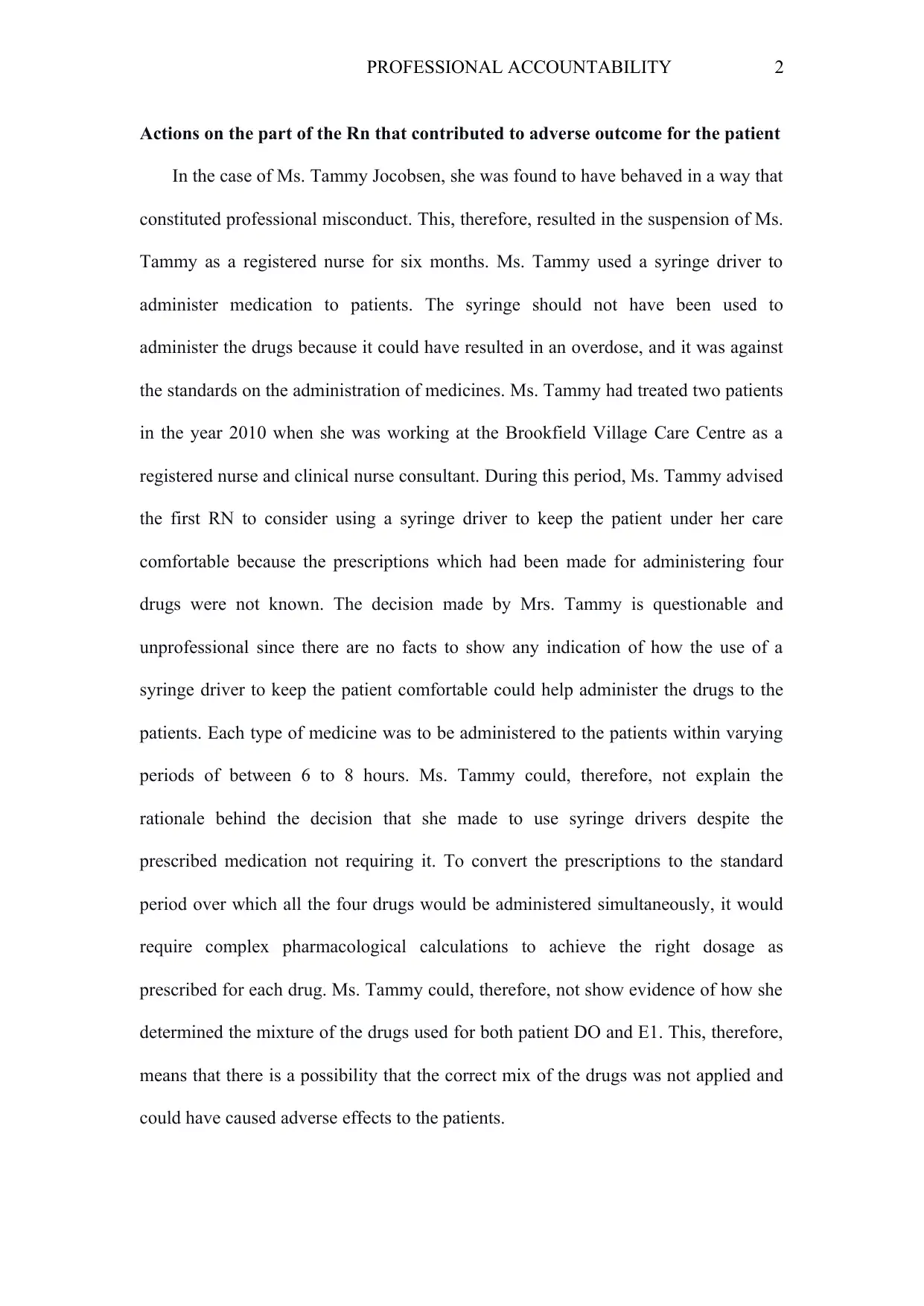
PROFESSIONAL ACCOUNTABILITY 2
Actions on the part of the Rn that contributed to adverse outcome for the patient
In the case of Ms. Tammy Jocobsen, she was found to have behaved in a way that
constituted professional misconduct. This, therefore, resulted in the suspension of Ms.
Tammy as a registered nurse for six months. Ms. Tammy used a syringe driver to
administer medication to patients. The syringe should not have been used to
administer the drugs because it could have resulted in an overdose, and it was against
the standards on the administration of medicines. Ms. Tammy had treated two patients
in the year 2010 when she was working at the Brookfield Village Care Centre as a
registered nurse and clinical nurse consultant. During this period, Ms. Tammy advised
the first RN to consider using a syringe driver to keep the patient under her care
comfortable because the prescriptions which had been made for administering four
drugs were not known. The decision made by Mrs. Tammy is questionable and
unprofessional since there are no facts to show any indication of how the use of a
syringe driver to keep the patient comfortable could help administer the drugs to the
patients. Each type of medicine was to be administered to the patients within varying
periods of between 6 to 8 hours. Ms. Tammy could, therefore, not explain the
rationale behind the decision that she made to use syringe drivers despite the
prescribed medication not requiring it. To convert the prescriptions to the standard
period over which all the four drugs would be administered simultaneously, it would
require complex pharmacological calculations to achieve the right dosage as
prescribed for each drug. Ms. Tammy could, therefore, not show evidence of how she
determined the mixture of the drugs used for both patient DO and E1. This, therefore,
means that there is a possibility that the correct mix of the drugs was not applied and
could have caused adverse effects to the patients.
Actions on the part of the Rn that contributed to adverse outcome for the patient
In the case of Ms. Tammy Jocobsen, she was found to have behaved in a way that
constituted professional misconduct. This, therefore, resulted in the suspension of Ms.
Tammy as a registered nurse for six months. Ms. Tammy used a syringe driver to
administer medication to patients. The syringe should not have been used to
administer the drugs because it could have resulted in an overdose, and it was against
the standards on the administration of medicines. Ms. Tammy had treated two patients
in the year 2010 when she was working at the Brookfield Village Care Centre as a
registered nurse and clinical nurse consultant. During this period, Ms. Tammy advised
the first RN to consider using a syringe driver to keep the patient under her care
comfortable because the prescriptions which had been made for administering four
drugs were not known. The decision made by Mrs. Tammy is questionable and
unprofessional since there are no facts to show any indication of how the use of a
syringe driver to keep the patient comfortable could help administer the drugs to the
patients. Each type of medicine was to be administered to the patients within varying
periods of between 6 to 8 hours. Ms. Tammy could, therefore, not explain the
rationale behind the decision that she made to use syringe drivers despite the
prescribed medication not requiring it. To convert the prescriptions to the standard
period over which all the four drugs would be administered simultaneously, it would
require complex pharmacological calculations to achieve the right dosage as
prescribed for each drug. Ms. Tammy could, therefore, not show evidence of how she
determined the mixture of the drugs used for both patient DO and E1. This, therefore,
means that there is a possibility that the correct mix of the drugs was not applied and
could have caused adverse effects to the patients.
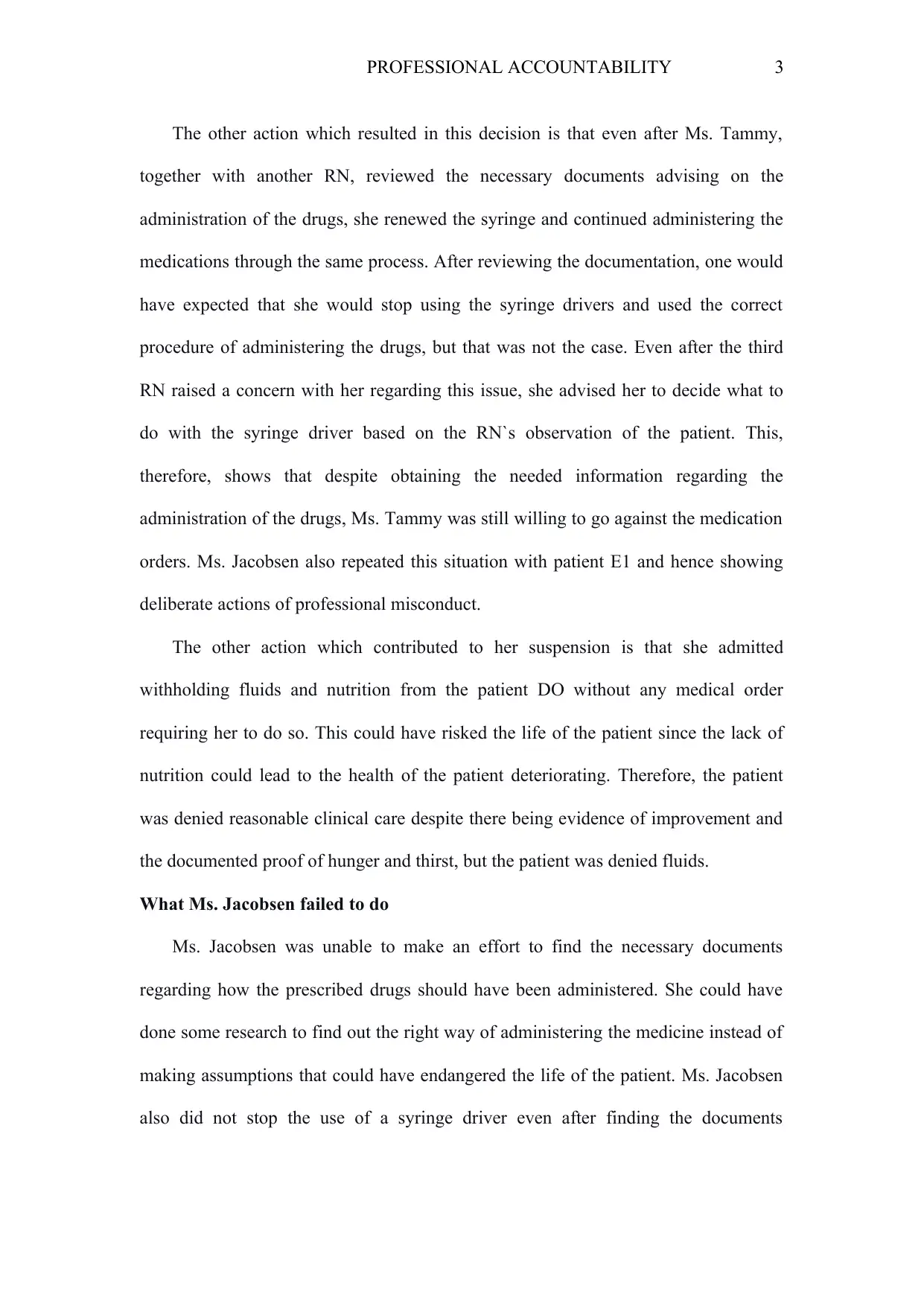
PROFESSIONAL ACCOUNTABILITY 3
The other action which resulted in this decision is that even after Ms. Tammy,
together with another RN, reviewed the necessary documents advising on the
administration of the drugs, she renewed the syringe and continued administering the
medications through the same process. After reviewing the documentation, one would
have expected that she would stop using the syringe drivers and used the correct
procedure of administering the drugs, but that was not the case. Even after the third
RN raised a concern with her regarding this issue, she advised her to decide what to
do with the syringe driver based on the RN`s observation of the patient. This,
therefore, shows that despite obtaining the needed information regarding the
administration of the drugs, Ms. Tammy was still willing to go against the medication
orders. Ms. Jacobsen also repeated this situation with patient E1 and hence showing
deliberate actions of professional misconduct.
The other action which contributed to her suspension is that she admitted
withholding fluids and nutrition from the patient DO without any medical order
requiring her to do so. This could have risked the life of the patient since the lack of
nutrition could lead to the health of the patient deteriorating. Therefore, the patient
was denied reasonable clinical care despite there being evidence of improvement and
the documented proof of hunger and thirst, but the patient was denied fluids.
What Ms. Jacobsen failed to do
Ms. Jacobsen was unable to make an effort to find the necessary documents
regarding how the prescribed drugs should have been administered. She could have
done some research to find out the right way of administering the medicine instead of
making assumptions that could have endangered the life of the patient. Ms. Jacobsen
also did not stop the use of a syringe driver even after finding the documents
The other action which resulted in this decision is that even after Ms. Tammy,
together with another RN, reviewed the necessary documents advising on the
administration of the drugs, she renewed the syringe and continued administering the
medications through the same process. After reviewing the documentation, one would
have expected that she would stop using the syringe drivers and used the correct
procedure of administering the drugs, but that was not the case. Even after the third
RN raised a concern with her regarding this issue, she advised her to decide what to
do with the syringe driver based on the RN`s observation of the patient. This,
therefore, shows that despite obtaining the needed information regarding the
administration of the drugs, Ms. Tammy was still willing to go against the medication
orders. Ms. Jacobsen also repeated this situation with patient E1 and hence showing
deliberate actions of professional misconduct.
The other action which contributed to her suspension is that she admitted
withholding fluids and nutrition from the patient DO without any medical order
requiring her to do so. This could have risked the life of the patient since the lack of
nutrition could lead to the health of the patient deteriorating. Therefore, the patient
was denied reasonable clinical care despite there being evidence of improvement and
the documented proof of hunger and thirst, but the patient was denied fluids.
What Ms. Jacobsen failed to do
Ms. Jacobsen was unable to make an effort to find the necessary documents
regarding how the prescribed drugs should have been administered. She could have
done some research to find out the right way of administering the medicine instead of
making assumptions that could have endangered the life of the patient. Ms. Jacobsen
also did not stop the use of a syringe driver even after finding the documents
⊘ This is a preview!⊘
Do you want full access?
Subscribe today to unlock all pages.

Trusted by 1+ million students worldwide
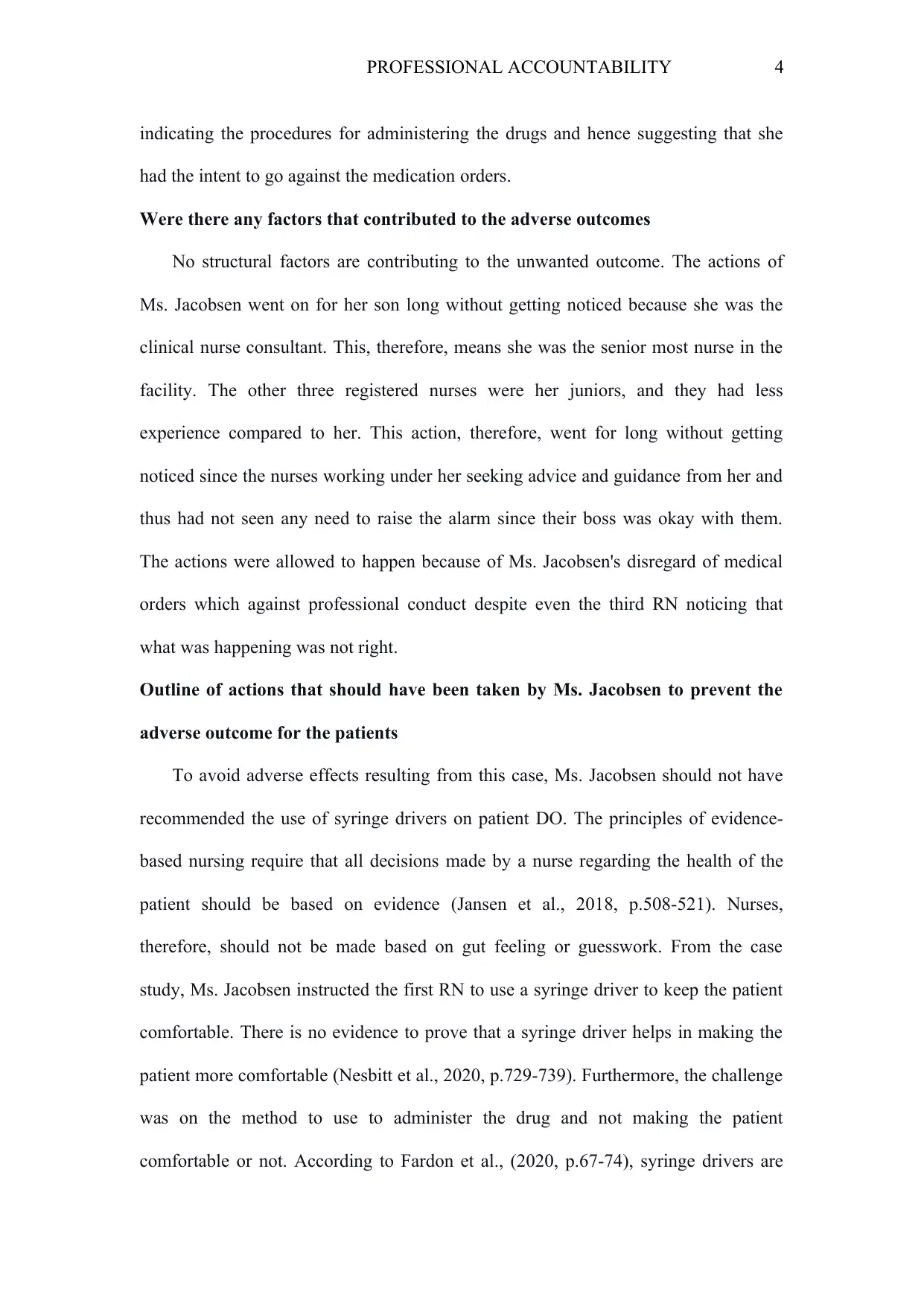
PROFESSIONAL ACCOUNTABILITY 4
indicating the procedures for administering the drugs and hence suggesting that she
had the intent to go against the medication orders.
Were there any factors that contributed to the adverse outcomes
No structural factors are contributing to the unwanted outcome. The actions of
Ms. Jacobsen went on for her son long without getting noticed because she was the
clinical nurse consultant. This, therefore, means she was the senior most nurse in the
facility. The other three registered nurses were her juniors, and they had less
experience compared to her. This action, therefore, went for long without getting
noticed since the nurses working under her seeking advice and guidance from her and
thus had not seen any need to raise the alarm since their boss was okay with them.
The actions were allowed to happen because of Ms. Jacobsen's disregard of medical
orders which against professional conduct despite even the third RN noticing that
what was happening was not right.
Outline of actions that should have been taken by Ms. Jacobsen to prevent the
adverse outcome for the patients
To avoid adverse effects resulting from this case, Ms. Jacobsen should not have
recommended the use of syringe drivers on patient DO. The principles of evidence-
based nursing require that all decisions made by a nurse regarding the health of the
patient should be based on evidence (Jansen et al., 2018, p.508-521). Nurses,
therefore, should not be made based on gut feeling or guesswork. From the case
study, Ms. Jacobsen instructed the first RN to use a syringe driver to keep the patient
comfortable. There is no evidence to prove that a syringe driver helps in making the
patient more comfortable (Nesbitt et al., 2020, p.729-739). Furthermore, the challenge
was on the method to use to administer the drug and not making the patient
comfortable or not. According to Fardon et al., (2020, p.67-74), syringe drivers are
indicating the procedures for administering the drugs and hence suggesting that she
had the intent to go against the medication orders.
Were there any factors that contributed to the adverse outcomes
No structural factors are contributing to the unwanted outcome. The actions of
Ms. Jacobsen went on for her son long without getting noticed because she was the
clinical nurse consultant. This, therefore, means she was the senior most nurse in the
facility. The other three registered nurses were her juniors, and they had less
experience compared to her. This action, therefore, went for long without getting
noticed since the nurses working under her seeking advice and guidance from her and
thus had not seen any need to raise the alarm since their boss was okay with them.
The actions were allowed to happen because of Ms. Jacobsen's disregard of medical
orders which against professional conduct despite even the third RN noticing that
what was happening was not right.
Outline of actions that should have been taken by Ms. Jacobsen to prevent the
adverse outcome for the patients
To avoid adverse effects resulting from this case, Ms. Jacobsen should not have
recommended the use of syringe drivers on patient DO. The principles of evidence-
based nursing require that all decisions made by a nurse regarding the health of the
patient should be based on evidence (Jansen et al., 2018, p.508-521). Nurses,
therefore, should not be made based on gut feeling or guesswork. From the case
study, Ms. Jacobsen instructed the first RN to use a syringe driver to keep the patient
comfortable. There is no evidence to prove that a syringe driver helps in making the
patient more comfortable (Nesbitt et al., 2020, p.729-739). Furthermore, the challenge
was on the method to use to administer the drug and not making the patient
comfortable or not. According to Fardon et al., (2020, p.67-74), syringe drivers are
Paraphrase This Document
Need a fresh take? Get an instant paraphrase of this document with our AI Paraphraser
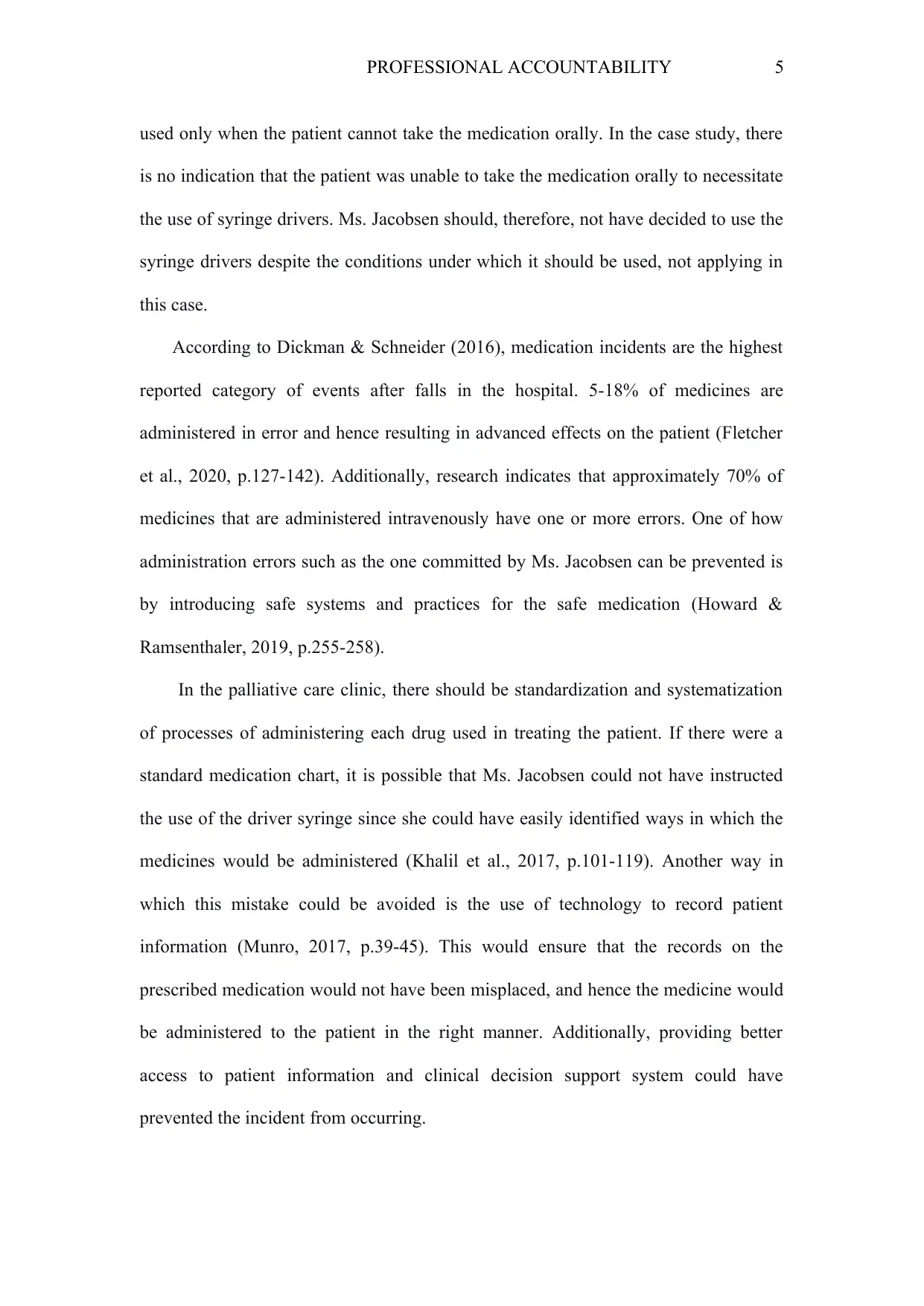
PROFESSIONAL ACCOUNTABILITY 5
used only when the patient cannot take the medication orally. In the case study, there
is no indication that the patient was unable to take the medication orally to necessitate
the use of syringe drivers. Ms. Jacobsen should, therefore, not have decided to use the
syringe drivers despite the conditions under which it should be used, not applying in
this case.
According to Dickman & Schneider (2016), medication incidents are the highest
reported category of events after falls in the hospital. 5-18% of medicines are
administered in error and hence resulting in advanced effects on the patient (Fletcher
et al., 2020, p.127-142). Additionally, research indicates that approximately 70% of
medicines that are administered intravenously have one or more errors. One of how
administration errors such as the one committed by Ms. Jacobsen can be prevented is
by introducing safe systems and practices for the safe medication (Howard &
Ramsenthaler, 2019, p.255-258).
In the palliative care clinic, there should be standardization and systematization
of processes of administering each drug used in treating the patient. If there were a
standard medication chart, it is possible that Ms. Jacobsen could not have instructed
the use of the driver syringe since she could have easily identified ways in which the
medicines would be administered (Khalil et al., 2017, p.101-119). Another way in
which this mistake could be avoided is the use of technology to record patient
information (Munro, 2017, p.39-45). This would ensure that the records on the
prescribed medication would not have been misplaced, and hence the medicine would
be administered to the patient in the right manner. Additionally, providing better
access to patient information and clinical decision support system could have
prevented the incident from occurring.
used only when the patient cannot take the medication orally. In the case study, there
is no indication that the patient was unable to take the medication orally to necessitate
the use of syringe drivers. Ms. Jacobsen should, therefore, not have decided to use the
syringe drivers despite the conditions under which it should be used, not applying in
this case.
According to Dickman & Schneider (2016), medication incidents are the highest
reported category of events after falls in the hospital. 5-18% of medicines are
administered in error and hence resulting in advanced effects on the patient (Fletcher
et al., 2020, p.127-142). Additionally, research indicates that approximately 70% of
medicines that are administered intravenously have one or more errors. One of how
administration errors such as the one committed by Ms. Jacobsen can be prevented is
by introducing safe systems and practices for the safe medication (Howard &
Ramsenthaler, 2019, p.255-258).
In the palliative care clinic, there should be standardization and systematization
of processes of administering each drug used in treating the patient. If there were a
standard medication chart, it is possible that Ms. Jacobsen could not have instructed
the use of the driver syringe since she could have easily identified ways in which the
medicines would be administered (Khalil et al., 2017, p.101-119). Another way in
which this mistake could be avoided is the use of technology to record patient
information (Munro, 2017, p.39-45). This would ensure that the records on the
prescribed medication would not have been misplaced, and hence the medicine would
be administered to the patient in the right manner. Additionally, providing better
access to patient information and clinical decision support system could have
prevented the incident from occurring.
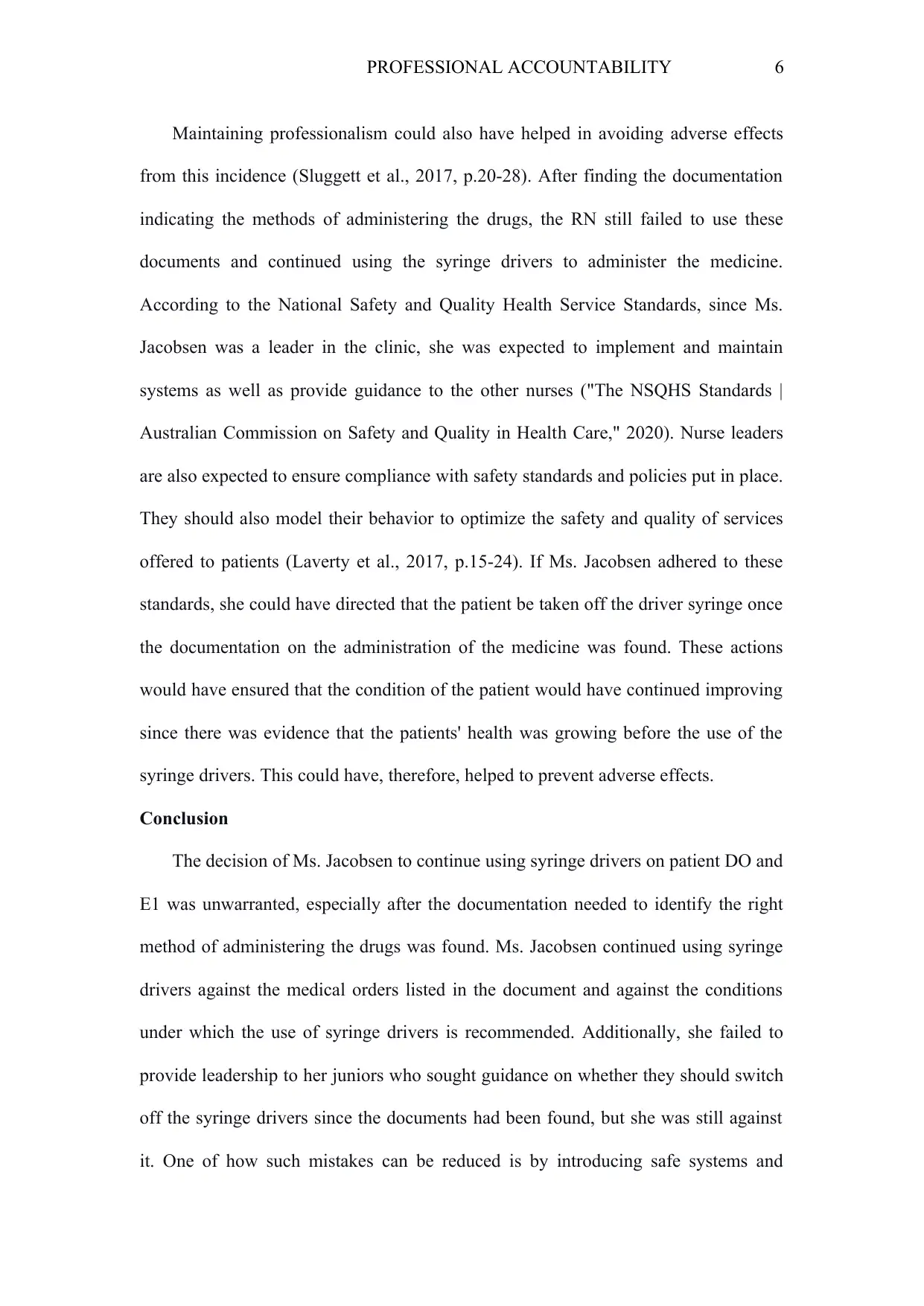
PROFESSIONAL ACCOUNTABILITY 6
Maintaining professionalism could also have helped in avoiding adverse effects
from this incidence (Sluggett et al., 2017, p.20-28). After finding the documentation
indicating the methods of administering the drugs, the RN still failed to use these
documents and continued using the syringe drivers to administer the medicine.
According to the National Safety and Quality Health Service Standards, since Ms.
Jacobsen was a leader in the clinic, she was expected to implement and maintain
systems as well as provide guidance to the other nurses ("The NSQHS Standards |
Australian Commission on Safety and Quality in Health Care," 2020). Nurse leaders
are also expected to ensure compliance with safety standards and policies put in place.
They should also model their behavior to optimize the safety and quality of services
offered to patients (Laverty et al., 2017, p.15-24). If Ms. Jacobsen adhered to these
standards, she could have directed that the patient be taken off the driver syringe once
the documentation on the administration of the medicine was found. These actions
would have ensured that the condition of the patient would have continued improving
since there was evidence that the patients' health was growing before the use of the
syringe drivers. This could have, therefore, helped to prevent adverse effects.
Conclusion
The decision of Ms. Jacobsen to continue using syringe drivers on patient DO and
E1 was unwarranted, especially after the documentation needed to identify the right
method of administering the drugs was found. Ms. Jacobsen continued using syringe
drivers against the medical orders listed in the document and against the conditions
under which the use of syringe drivers is recommended. Additionally, she failed to
provide leadership to her juniors who sought guidance on whether they should switch
off the syringe drivers since the documents had been found, but she was still against
it. One of how such mistakes can be reduced is by introducing safe systems and
Maintaining professionalism could also have helped in avoiding adverse effects
from this incidence (Sluggett et al., 2017, p.20-28). After finding the documentation
indicating the methods of administering the drugs, the RN still failed to use these
documents and continued using the syringe drivers to administer the medicine.
According to the National Safety and Quality Health Service Standards, since Ms.
Jacobsen was a leader in the clinic, she was expected to implement and maintain
systems as well as provide guidance to the other nurses ("The NSQHS Standards |
Australian Commission on Safety and Quality in Health Care," 2020). Nurse leaders
are also expected to ensure compliance with safety standards and policies put in place.
They should also model their behavior to optimize the safety and quality of services
offered to patients (Laverty et al., 2017, p.15-24). If Ms. Jacobsen adhered to these
standards, she could have directed that the patient be taken off the driver syringe once
the documentation on the administration of the medicine was found. These actions
would have ensured that the condition of the patient would have continued improving
since there was evidence that the patients' health was growing before the use of the
syringe drivers. This could have, therefore, helped to prevent adverse effects.
Conclusion
The decision of Ms. Jacobsen to continue using syringe drivers on patient DO and
E1 was unwarranted, especially after the documentation needed to identify the right
method of administering the drugs was found. Ms. Jacobsen continued using syringe
drivers against the medical orders listed in the document and against the conditions
under which the use of syringe drivers is recommended. Additionally, she failed to
provide leadership to her juniors who sought guidance on whether they should switch
off the syringe drivers since the documents had been found, but she was still against
it. One of how such mistakes can be reduced is by introducing safe systems and
⊘ This is a preview!⊘
Do you want full access?
Subscribe today to unlock all pages.

Trusted by 1+ million students worldwide
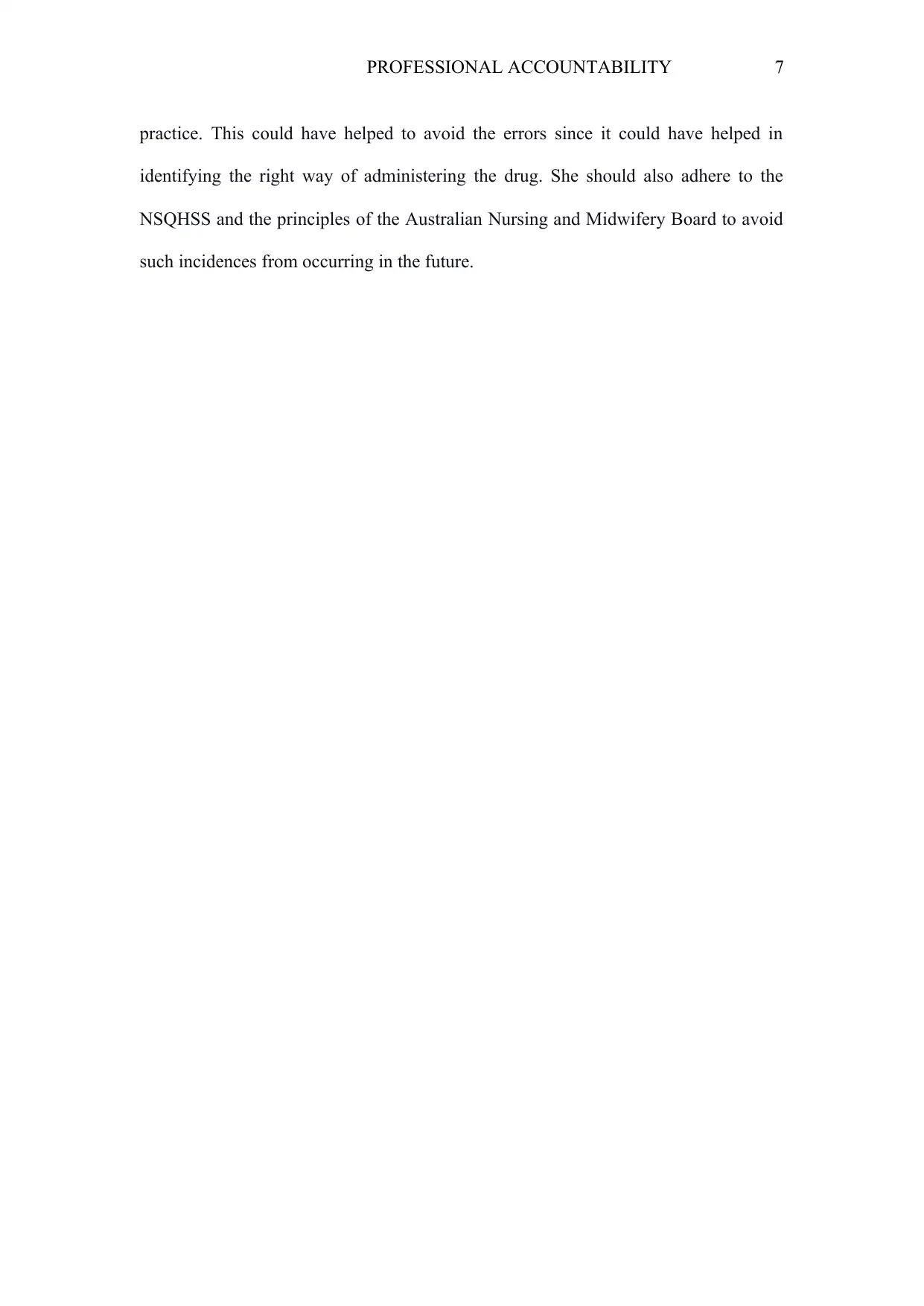
PROFESSIONAL ACCOUNTABILITY 7
practice. This could have helped to avoid the errors since it could have helped in
identifying the right way of administering the drug. She should also adhere to the
NSQHSS and the principles of the Australian Nursing and Midwifery Board to avoid
such incidences from occurring in the future.
practice. This could have helped to avoid the errors since it could have helped in
identifying the right way of administering the drug. She should also adhere to the
NSQHSS and the principles of the Australian Nursing and Midwifery Board to avoid
such incidences from occurring in the future.
Paraphrase This Document
Need a fresh take? Get an instant paraphrase of this document with our AI Paraphraser
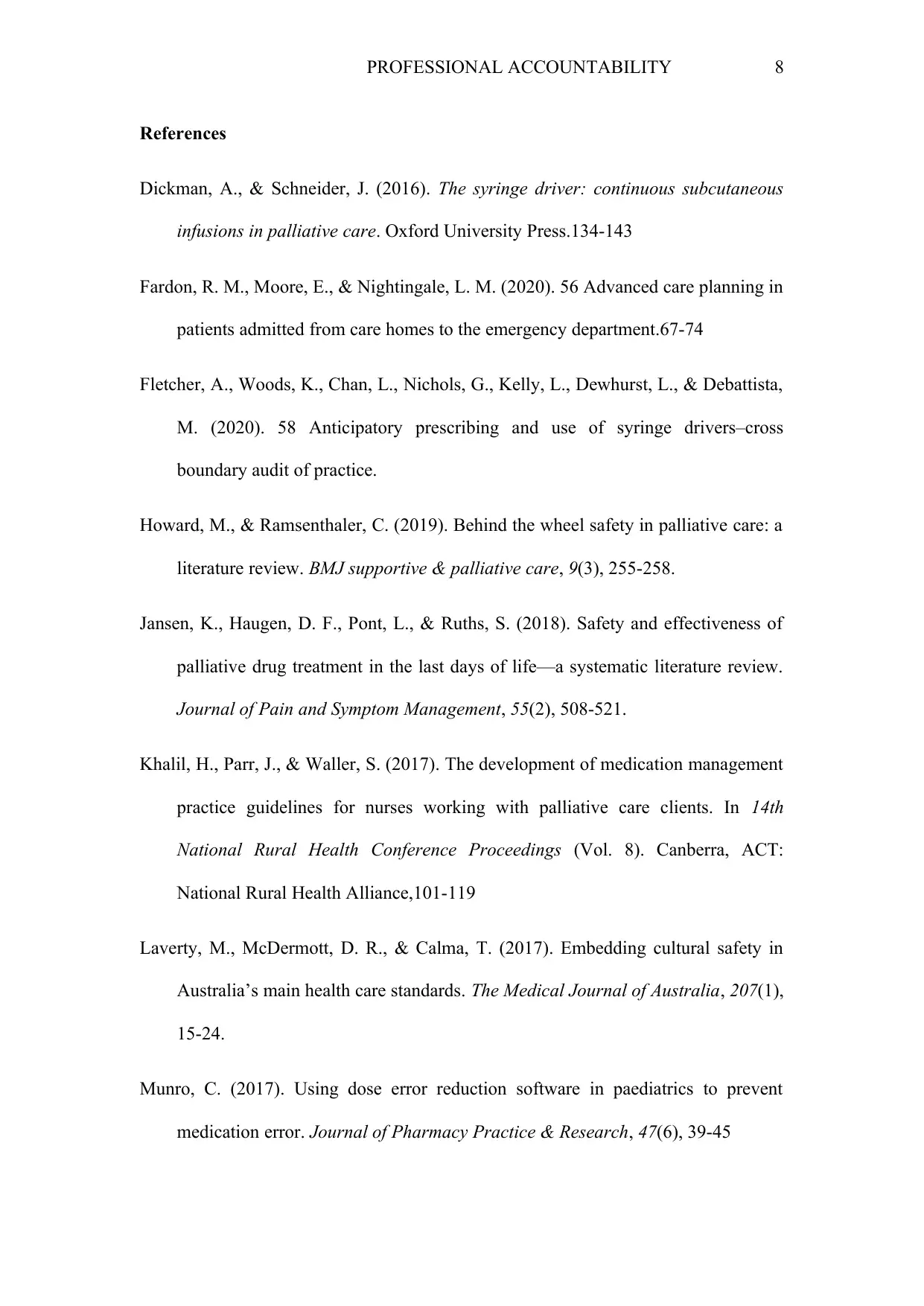
PROFESSIONAL ACCOUNTABILITY 8
References
Dickman, A., & Schneider, J. (2016). The syringe driver: continuous subcutaneous
infusions in palliative care. Oxford University Press.134-143
Fardon, R. M., Moore, E., & Nightingale, L. M. (2020). 56 Advanced care planning in
patients admitted from care homes to the emergency department.67-74
Fletcher, A., Woods, K., Chan, L., Nichols, G., Kelly, L., Dewhurst, L., & Debattista,
M. (2020). 58 Anticipatory prescribing and use of syringe drivers–cross
boundary audit of practice.
Howard, M., & Ramsenthaler, C. (2019). Behind the wheel safety in palliative care: a
literature review. BMJ supportive & palliative care, 9(3), 255-258.
Jansen, K., Haugen, D. F., Pont, L., & Ruths, S. (2018). Safety and effectiveness of
palliative drug treatment in the last days of life—a systematic literature review.
Journal of Pain and Symptom Management, 55(2), 508-521.
Khalil, H., Parr, J., & Waller, S. (2017). The development of medication management
practice guidelines for nurses working with palliative care clients. In 14th
National Rural Health Conference Proceedings (Vol. 8). Canberra, ACT:
National Rural Health Alliance,101-119
Laverty, M., McDermott, D. R., & Calma, T. (2017). Embedding cultural safety in
Australia’s main health care standards. The Medical Journal of Australia, 207(1),
15-24.
Munro, C. (2017). Using dose error reduction software in paediatrics to prevent
medication error. Journal of Pharmacy Practice & Research, 47(6), 39-45
References
Dickman, A., & Schneider, J. (2016). The syringe driver: continuous subcutaneous
infusions in palliative care. Oxford University Press.134-143
Fardon, R. M., Moore, E., & Nightingale, L. M. (2020). 56 Advanced care planning in
patients admitted from care homes to the emergency department.67-74
Fletcher, A., Woods, K., Chan, L., Nichols, G., Kelly, L., Dewhurst, L., & Debattista,
M. (2020). 58 Anticipatory prescribing and use of syringe drivers–cross
boundary audit of practice.
Howard, M., & Ramsenthaler, C. (2019). Behind the wheel safety in palliative care: a
literature review. BMJ supportive & palliative care, 9(3), 255-258.
Jansen, K., Haugen, D. F., Pont, L., & Ruths, S. (2018). Safety and effectiveness of
palliative drug treatment in the last days of life—a systematic literature review.
Journal of Pain and Symptom Management, 55(2), 508-521.
Khalil, H., Parr, J., & Waller, S. (2017). The development of medication management
practice guidelines for nurses working with palliative care clients. In 14th
National Rural Health Conference Proceedings (Vol. 8). Canberra, ACT:
National Rural Health Alliance,101-119
Laverty, M., McDermott, D. R., & Calma, T. (2017). Embedding cultural safety in
Australia’s main health care standards. The Medical Journal of Australia, 207(1),
15-24.
Munro, C. (2017). Using dose error reduction software in paediatrics to prevent
medication error. Journal of Pharmacy Practice & Research, 47(6), 39-45
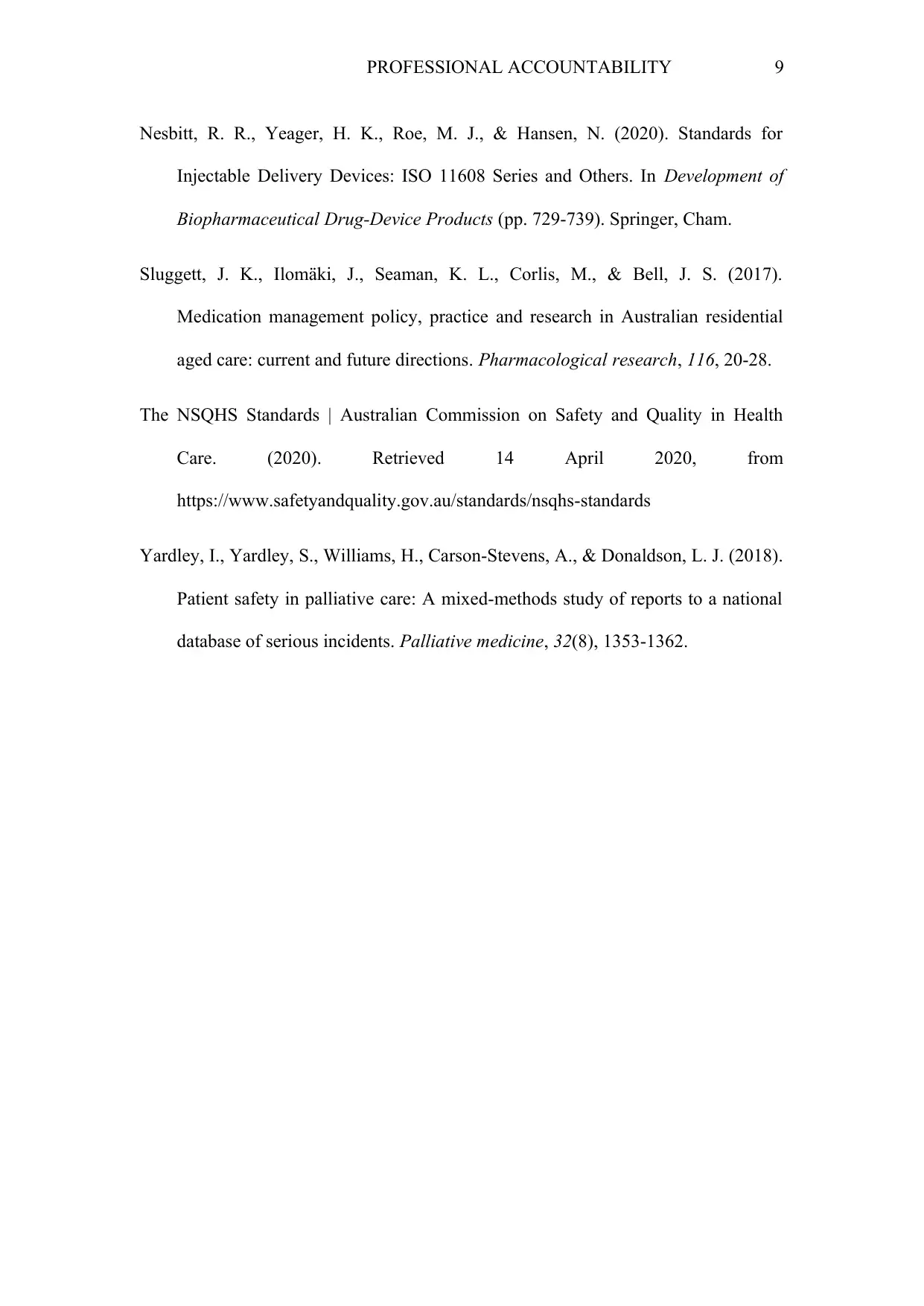
PROFESSIONAL ACCOUNTABILITY 9
Nesbitt, R. R., Yeager, H. K., Roe, M. J., & Hansen, N. (2020). Standards for
Injectable Delivery Devices: ISO 11608 Series and Others. In Development of
Biopharmaceutical Drug-Device Products (pp. 729-739). Springer, Cham.
Sluggett, J. K., Ilomäki, J., Seaman, K. L., Corlis, M., & Bell, J. S. (2017).
Medication management policy, practice and research in Australian residential
aged care: current and future directions. Pharmacological research, 116, 20-28.
The NSQHS Standards | Australian Commission on Safety and Quality in Health
Care. (2020). Retrieved 14 April 2020, from
https://www.safetyandquality.gov.au/standards/nsqhs-standards
Yardley, I., Yardley, S., Williams, H., Carson-Stevens, A., & Donaldson, L. J. (2018).
Patient safety in palliative care: A mixed-methods study of reports to a national
database of serious incidents. Palliative medicine, 32(8), 1353-1362.
Nesbitt, R. R., Yeager, H. K., Roe, M. J., & Hansen, N. (2020). Standards for
Injectable Delivery Devices: ISO 11608 Series and Others. In Development of
Biopharmaceutical Drug-Device Products (pp. 729-739). Springer, Cham.
Sluggett, J. K., Ilomäki, J., Seaman, K. L., Corlis, M., & Bell, J. S. (2017).
Medication management policy, practice and research in Australian residential
aged care: current and future directions. Pharmacological research, 116, 20-28.
The NSQHS Standards | Australian Commission on Safety and Quality in Health
Care. (2020). Retrieved 14 April 2020, from
https://www.safetyandquality.gov.au/standards/nsqhs-standards
Yardley, I., Yardley, S., Williams, H., Carson-Stevens, A., & Donaldson, L. J. (2018).
Patient safety in palliative care: A mixed-methods study of reports to a national
database of serious incidents. Palliative medicine, 32(8), 1353-1362.
⊘ This is a preview!⊘
Do you want full access?
Subscribe today to unlock all pages.

Trusted by 1+ million students worldwide
1 out of 9
Related Documents
Your All-in-One AI-Powered Toolkit for Academic Success.
+13062052269
info@desklib.com
Available 24*7 on WhatsApp / Email
![[object Object]](/_next/static/media/star-bottom.7253800d.svg)
Unlock your academic potential
Copyright © 2020–2025 A2Z Services. All Rights Reserved. Developed and managed by ZUCOL.





